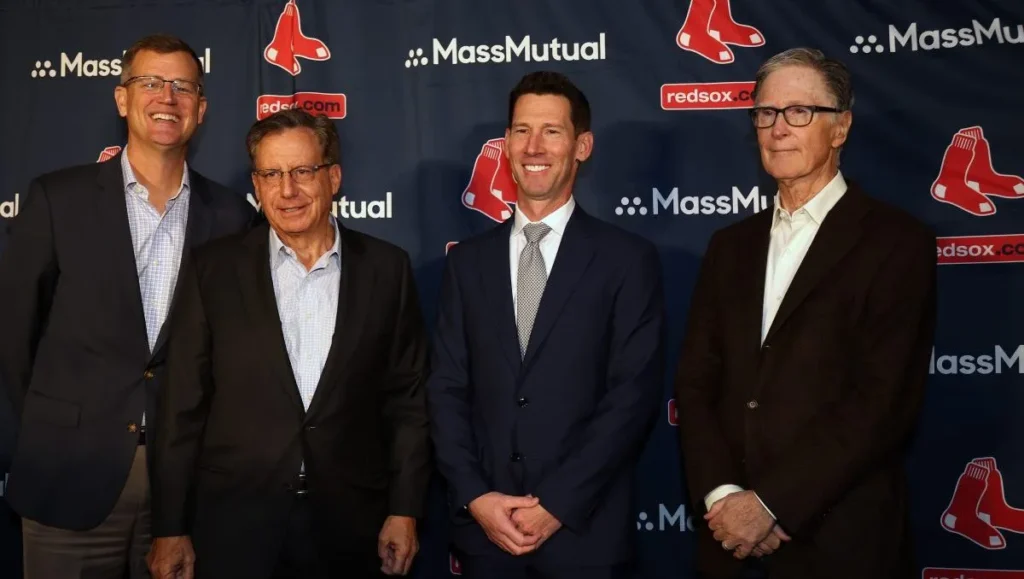The hushed anticipation in the Fenway Park offices was palpable. For weeks, rumors had swirled like autumn leaves caught in a New England gale: the Boston Red Sox, long slumbering giants of the American League East, were poised to make a seismic trade, acquiring Washington Nationals superstar Juan Soto. Now, in a windowless conference room smelling faintly of stale coffee and nervous sweat, the moment of truth had arrived.
On one side of the mahogany table sat Chaim Bloom, the Red Sox Chief Baseball Officer, his face a carefully constructed mask of calm professionalism, betraying nothing of the internal pressure he felt. Beside him sat his trusted lieutenant, Eddie Romero, their collective gaze fixed on the representatives of the New York Yankees across the table. This wasn’t a direct negotiation; the Yankees were acting as intermediaries, facilitating a complex three-way deal that would finally bring Soto to Boston.
Across the table sat Brian Cashman, the Yankees General Manager, a veteran of countless high-stakes negotiations, his expression equally inscrutable. He was flanked by Jason Zillo, the Yankees’ Senior Vice President of Public Relations and Communications, a man whose job was as much about damage control as it was about public announcements. The air crackled with unspoken tension, the silence punctuated only by the rhythmic ticking of a grandfather clock in the corner.
The Yankees weren’t simply acting as brokers. They had their own significant stake in the deal, seeking to acquire a player from the Nationals package who could bolster their own already formidable roster. This complex maneuver, orchestrated with meticulous secrecy, had been months in the making, requiring intricate negotiations and a delicate balance of risk and reward.
“So, let’s review the final terms,” Bloom began, his voice low and measured. He laid out a meticulously prepared document on the table, a testament to the countless hours spent poring over player statistics, contract details, and potential future projections.
The centerpiece of the deal, naturally, was Juan Soto. The 24-year-old phenom, with his otherworldly batting average and exceptional plate discipline, represented a generational talent, a player capable of single-handedly altering the trajectory of a franchise. For the Red Sox, he was the missing piece, the potential catalyst to ignite a team that had, for too long, been stuck in mediocrity.
The price, however, was steep. The Red Sox would be parting with a significant chunk of their minor league talent, including highly-touted pitching prospect, Jackson Chourio, widely considered a top-five prospect in all of baseball. They would also be surrendering a promising young outfielder, Marcelo Mayer, known for his exceptional power and defensive skills. These losses stung, but Bloom believed the acquisition of Soto outweighed the risk.
The Yankees, in turn, were acquiring a highly sought-after young shortstop from the Nationals, a player with exceptional defensive skills and a potent bat. This player, along with some smaller pieces from the Red Sox and Nationals, formed the core of the Yankees’ part of the trade, a move designed to strengthen their infield and add further depth to their already impressive lineup.
The negotiations had centered on the details – the precise structure of the player exchanges, the allocation of financial responsibilities, and the inclusion of various performance-based incentives. Each side had pushed and pulled, argued and compromised, until they reached this final, tense meeting.
Cashman, a master tactician, reviewed the documents with a critical eye, pausing occasionally to raise a subtle query, a calculated maneuver designed to test the Red Sox’s resolve. He understood the magnitude of the deal and the pressure weighing on both sides. A failed agreement could have devastating consequences for all involved.
After what felt like an eternity, a period of tense silence filled the room. Cashman finally leaned back, a faint smile playing on his lips. “It’s a bold move, Bloom,” he admitted, his voice laced with a hint of admiration. “But I believe it’s a sound one.”
Bloom nodded, a slight tremor in his hand as he reached for a pen. “We believe so as well, Mr. Cashman.”
With the stroke of a pen, the deal was finalized. The years of speculation, the months of intense negotiation, the countless hours of strategizing, all culminated in this single, decisive act. Juan Soto, the prodigious talent, was now a Boston Red Sox player. The ripple effect of this trade would be felt throughout the league, instantly shifting the balance of power in the American League East and setting the stage for what promised to be a thrilling and unpredictable season. The Red Sox, once sleeping giants, had awakened with a roar. The Yankees, having played their part, had positioned themselves to continue their own dominance. The baseball world held its breath, eager to witness the unfolding drama.

